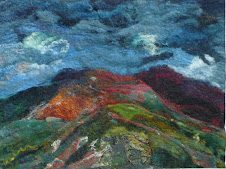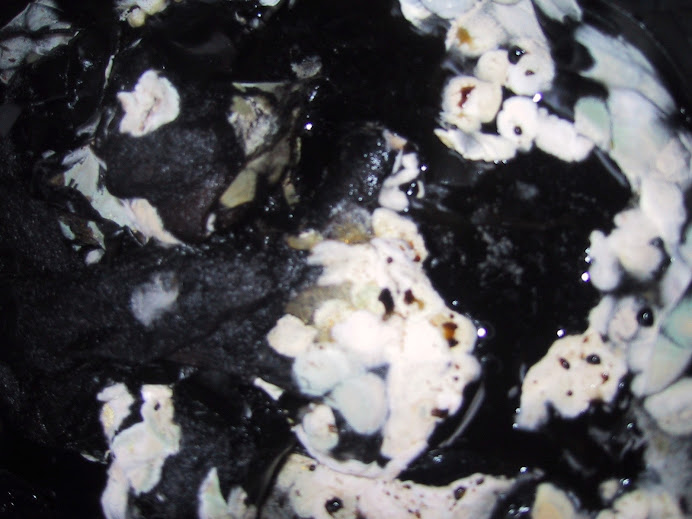 I wrote this blog as I actually did it. So I apologise it if sounds a bit too detailed. I thought I would try it as an experiment as I usually keep notes on my computer anyway.
I wrote this blog as I actually did it. So I apologise it if sounds a bit too detailed. I thought I would try it as an experiment as I usually keep notes on my computer anyway.I poured one litre of nearly boiling water over the leaves and left to steep for about half an hour (coffee break time!)
I squeezed out the leaves and the I. Isatis on the left, gave a characteristic sherry coloured liquid but with a pink cast. although this has not come out on the photograph. The I. Indigotica, on the right was darker in colour with almost a purplish cast.

I added 1 tablespoon of washing soda ( sodium carbonate) to each which gave a PH of between 9 and 10 a little higher than I intended. Then I whisked them both for 2 minutes (and did my wrist ache!)
I. Tinctoria went a light green then on beating for 2 minutes a dark green with a slightly blue froth.
I. Indigotica went a bright green followed by very dark green and after 2 minutes of beating the froth had a dark blue cast to it.
The I. Isatis was in a wide bowl and the I indigotica was in a three litre jug so when I squeezed the leaves out this was still very hot ( at about 60 degrees C) while the I. Tinctoria was just tepid.
I added 1/8th teaspoon of Thiourea Dioxide commonly known as spectralite as a deoxygenator to each and left them for half an hour. I did wonder whether the I. Tinctoria might need more being in a wide bowl where the liquid might have absorbed more oxygen. but decided to see what happened.
In the mean time I weighed out 25 g of wet mordanted leicester long wool curls for each vat (mordanted as that is what I had wet and ready for dyeing)
I decided it was a bit difficult to compare the two vats when they were in such different size bowls which effected the temperature so I transferred both vats into one litre jugs and placed in a big bowl with boiling water in to have them both at the same temperature and added a little more Thiourea Dioxide to compensate for adding oxygen as I transferred them, and left them for 10 minutes or so. The I Tinctoria was at 48 degrees the I. Indigotica was at 42 degrees C.
I added the fibres at 12.40 and left for 20 minutes. as I was interrupted by a phone call!
I removed both and allowed to oxidise for about 20 minutes. As you can see the I Indigotica ( the one on the right ) is a darker blue.

I put half of the fibres back for 5 minutes and both went a bit darker.
The dogs got walked at this point so I returned to my two little vats at 5.00pm adding more hot water to the bowl to warm them up, 25ml of washing soda solution* as the pH had dropped to 8 , and 1/8tsp approx of thiourea dioxide.
* Washing soda solution is made by adding 4 tablespoons of washing soda ( sodium carbonate) to 1 litre of water.
I then added back half again of the previous clump of curls. (pH between 8-9 and temp at 38 degrees C) and left for five minutes removed and oxidised. I went on doing this until the fibres really did not look any darker. You can these results below with I.Tintoria (the ordinary Woad) on top and the I. Indigotica (Chinese Woad) on the bottom. There was still colour in both vats so dyed some more fibres a nice light blue photo not shown as the light was going !
Ps DH (a very supportive and encouraging man) says to all readers of my blog READ THE MACHINE STOPS BY EM FORSTER and prepare for the future .



























Interesting comparison, Helen. And thanks for the link to the online book!
ReplyDeleteHi Leigh everytime I spend time a lot of time blogging DH with a huge grin goes past muttering -"what will you do when the machine stops?"
ReplyDeleteAnd Iam proud of getting my links working-finally- thanks to you and to Sue.
Very interesting. Thank you so much for this comparison!!
ReplyDeleteI found the detail absolutely fascinating - and I really like the darkest blues.
ReplyDeleteI'm glad I found your blog - both very nice blues, but I like the darker better. Your in depth detail of what you did was great.
ReplyDeleteHi Leena and welcome to Fiona d and Skyweaver I agree that the darker shades of the indigo blues are fabulous. I love them but to get a lot on the my fibres I will need to grow a lot. I have just dyed 100g of light blue using 200g of leaves which I picked from half a dozen plants of Isatis Indigotica I now realise why so many cultures wanted to find a way to extract the indigotin from these blue bearing plants.
ReplyDeletethanks for the details - esp. as some of those might make all the difference in natural dyeing! and I don't want to think about what happens when this machine stops:)) I would loose all my "textile" contacts - back to fiddling about on my own:(( nope, I definitely don't want to think about that scenario right now!
ReplyDeleteI agree Bettina-" the machine stopping" does not bear thinking about. I would be very isolated without my internet contacts. Few local friends are particularly interested in what I am doing or only marginally!
ReplyDeleteI am so glad to know that you and others who have said so have liked having detail.
Really good to see a pic of the leaves beforehand too. It gives a feel for how many leaves 100 grams is, and an idea of leaf size compared to (pretty standard) paper towel size.
ReplyDeleteOut of interest, if you pigmented the dye before dyeing with it, do you think you'd get a deeper colour, with both or either?
Also out of interest, did the two woads receive similar or any nitrogen fertiliser (in natural or artificial guide) and were they grown in the same area of garden?
And has the last week's lousy weather affected your plants (a week later from your original post).
Hi Robin what an interesting question! The two woads are in different parts of the garden but as my garden is not enormous it means they are about 20 foot apart. Both woads were planted into beda which had had organic chicken manure dug in and had both been watered twice with phostegen. The Chinese woad is in a much sunnier open position than the I. Tinctoria which is quite shaded by a large bush of Gensita Tinctoria but all four plants look very healthy and flourishing!
ReplyDeleteThe Chinese woad seems fine too in fact I get the impression that wet Wales suits it. We are in an microclimate here and the garden is surrounded by high hedges and two trees so although it gets windy we don't seem to get too much wind damage.
I am not sure what you mean by pigmenting the dye. Do you mean extracting the indigotin as a blue powder or a sludge? If so I have not tried that yet.
Thanks for the informative reply... so possibly the extra sun made for the increased pigment in the Chinese woad. I think it's been wetter down here and very windy some days, but my plants haven't been fed so well so that might also make a difference.
ReplyDeleteYes, I did mean pigmenting first, but I guess if you're dyeing straightaway then there's little point to that process.
sorry if not clear, I meant to say I did mean by pigmenting (extracting dye to a blue powder)
ReplyDeleteWell possibly the extra sunlight has made a difference but Annee Silk who sent me the seeds also says that the I. Indigotica has more indogotin and so too does Dominque Cardon and it was a quite a significant difference too.
ReplyDeleteI'm sure you're right... twas just a thought! Thanks again for your openness on it all.
ReplyDelete